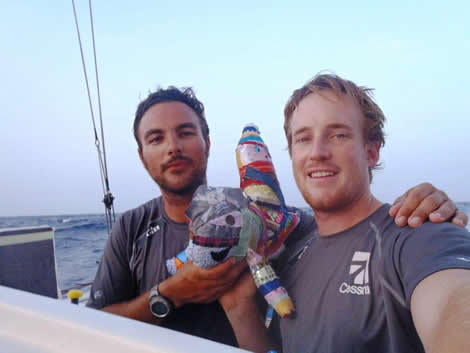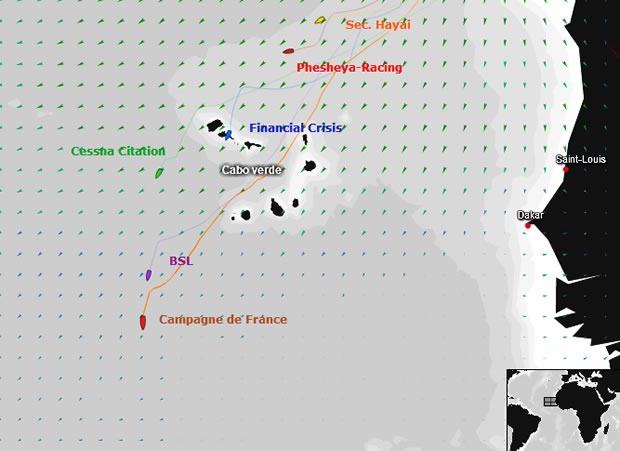Out of the Cape Verdes' grip
As the double-handed, Class40 Global Ocean Race fleet straddle the Cape Verde Islands, the route through the North Atlantic archipelago has presented a variety of risks and options for the six boats. Leading Class40, Campagne de France, with BSL in second, took the more direct route straight through the islands with both boats slowing dramatically. Ross and Campbell Field were becalmed on BSL while Halvard Mabire and Miranda Merron exited the Cape Verdes with a 50-mile lead over the New Zealand duo who waited until dusk on Thursday before breeze arrived and BSL picked up speed to eight knots.
Opting to leave the islands to port, Conrad Colman and Hugo Ramon in third on Cessna Citation gybed around Santo Antao at the northwestern edge of the archipelago at 02:00 GMT on Friday, adding distance to their route and trailing BSL by 150 miles. Meanwhile, 85 miles northeast of Santo Antao and closing down the gap to Colman and Ramon to 68 miles, Marco Nannini and Paul Peggs on Financial Crisis sailed a hotter angle due west producing the highest speed in the fleet of 10-11 knots in around 15-17 knots of breeze. In the strongest breeze of around 20 knots, 200 miles north of the islands, Phesheya-Racing and Sec. Hayai continued to bank miles to the west with the two Class40s separated by just over 30 miles.
By midday on Friday, Mabire and Merron had built a 70-mile lead over BSL: “Deep blue water, 32°, perfect for a bucket shower at the back of the boat,” reported Miranda Merron in the morning. “Bliss to be clean, salt and sweat-free and dry, just for the short time frame for the wind to change, requiring a rearrangement in sauna-like conditions of the entire interior of Campagne de France. It’s very hot and humid.”
For Mabire and Merron, taking the route through the islands was a calculated risk: “We knew there would always be the threat of light winds and calm conditions, but it was the most direct route and seemed the most logical plan,” explained Mabire. “As Class40s are relatively small boats, you’ve really got to avoid putting in extra miles. We’re not on a massive, Jules Verne multihull capable of making 700 miles a day where you can shoot off to hunt down a good looking area of weather and position yourself in the most favourable spot.”
During the 2008-09 GOR, the average speed of the winning double-handed Class40, Beluga Racer, for the complete circumnavigation was 8.18 knots. “On a Class40 it’s difficult to predict or rely on what will happen 500-1,000 miles down the course as the whole situation may have changed by the time you get there.”
While the temperature was climbing rapidly on Campagne de France, Mabire notes that the scenery is also changing: “The nights are stunning with the first part of the evening lit by a three-quarter moon and as we descend south, the star map is beginning to change,” he observes. “The Great Bear constellation is becoming increasingly low on the horizon to the north and the Southern Cross is now starting to appear ahead of us. As a youngster, back in the days before the God of GPS arrived and men still looked at the sky instead of a small screen, I remember trying to locate the Great Bear or Ursa Major and couldn’t get to grips with the idea of the bear description,” he recalls. “Consequently, I had further trouble spotting Ursa Minor and then locating the vital Pole Star that has guided sailors since the beginning of time. If someone had only explained that when searching for the Great Bear I should look for a saucepan with a bent handle, life would have been far simpler!”
Trailing the leaders by 213 miles, Conrad Colman and Hugo Ramon in third with Cessna Citation had left the Cape Verdes 100 miles astern by midday and the duo were continuing to work westwards. “So, the ocean race is now starting,” stated 26 year-old Ramon on Thursday night. “Until now we have all followed more or less the same route.”
For the past week, the only viable breeze was a band along the western coast of Africa for almost 900 miles from the Straits of Gibraltar southwards, forcing the fleet inshore. “Then there were suddenly two options: leave the archipelago of Cape Verde to port, or go straight through the middle. Our systems of data analysis advised us, based on meteorology and our polars, to leave the islands to port.”
The duo’s faith in their navigation software took a slight wobble when the vastly experienced teams on Campagne de France and BSL opted for the shorter route. “But when we saw the ‘Big Bosses’ were going through the middle, it made us think a lot,” he admits. “However, our strategy is long term and to make gains that will materialise in four or five days, not immediately.” One of the primary reasons for sticking to the plan of keeping west of the archipelago lay waiting south of the Cape Verdes just to the south-east of the ‘Bog Bosses’: “There’s a an area of light wind sitting there and there’s a real chance it could spread right into our path,” Ramon confirms.

In the 15:00 GMT position poll on Friday, Marco Nannini and Paul Peggs were sailing Financial Crisis through the narrow channel between Sao Vicente and the small island of Santa Luzia; the duo’s approach to the islands is a boom or bust option. Sailing in 13-16 knots of NE breeze and searing temperatures, Nannini reported Sao Vincente was hard to spot.
As Financial Crisis threaded through the Cape Verde Islands, Nick Leggatt and Phillippa Hutton-Squire were 145 miles north-east of Peggs and Nannini making the best speed in the fleet on Friday afternoon with Phesheya-Racing adding an extra 29 miles into their lead over Nico Budel and Ruud van Rijsewijk on Sec. Hayai in the past 24 hours. “The last 24 hours has been all about watching the wind shifts and making the appropriate decisions,” said Hutton-Squire late on Friday afternoon. “We have gybed a few times, put reefs in and shaken them out and we were lucky enough to have a very bright moon last night which made helming so much easier.” Similar to the rest of the GOR fleet, the South African duo are feeling the heat: “Today it is just far too hot out on deck to even think about doing some helming and next on the agenda for today is a shower!!”
For Phesheya-Racing and Sec. Hayai north of the Cape Verdes and Financial Crisis currently passing through the archipelago, the wind should remain strongest, but a wall of sub-12 knot breeze is threatening the path south on Saturday for the Class40s already clear of the islands.
With a number of high-profile team mascots in the GOR fleet, Hugo Ramon has revealed an addition on Cessna Citation: “This mascot has been made by the kids of a little town of France called Mons,” says the Spanish skipper. “Four of these children were present at the start of the GOR in Palma. These kids and I have been in touch and doing educational projects since my second Mini Transat 6.50 in 2007. Their teacher has made an impressive job of including all my ocean races as part of their lessons,” he explains. “This mascot is called ‘Flashy’ (see image gallery) and is made with a piece of cloth of every single student at the school, so it’s very important to us. With Flashy we have lots of hearts and minds focused on board. Flashy is not going to live imaginary adventures, but he will be the eyes of these kids in every single adventure we have in the GOR 2011-2012.”










Latest Comments
Add a comment - Members log in